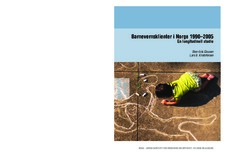| dc.contributor.author | Clausen, Sten-Erik | |
| dc.contributor.author | Kristofersen, Lars Bjarne | |
| dc.date.accessioned | 2020-06-07T21:05:24Z | |
| dc.date.accessioned | 2021-04-29T14:13:09Z | |
| dc.date.available | 2020-06-07T21:05:24Z | |
| dc.date.available | 2021-04-29T14:13:09Z | |
| dc.date.issued | 2008 | |
| dc.identifier.isbn | 978-82-78-94277-2 | |
| dc.identifier.issn | 0808-5013 | |
| dc.identifier.uri | https://hdl.handle.net/20.500.12199/3269 | |
| dc.description.abstract | This report presents some results from a register data study of Norwegian child welfare clients. We focus mainly on their outcomes as adults concerning education, income, social benefits and employment. We also present some results about the duration of different child welfare careers. Further, we present some analyses of the timing of intervention and after care support. Methods Study population: The study population consists of all child welfare clients in Norway between 1990 and 2005. This constitutes a total of 120,986 former and present clients from 0 to 37 years of age. The data used is register data from Statistics Norway, and the design is longitudinal. The data file also consists of a comparison sample of 112,412 children and young adults who have not been in contact with the Child Welfare authorities. VariablesThe child welfare register contains the reasons for intervention, the types of interventions and who reported the case. These variables have been recorded each year. Other register data are also added to the file. These include among others, charges with crimes, social assistance, causes of death, disablement benefit, education, income, marital status and country background. Results Foster homes careers. We defined long-term foster care as placements that have lasted longer than 3 years. About 30 % of the foster care careers last 4 years or more.Adult outcomes. Former child welfare clients achieve lower education levels than their peers in the general population. They have also lower income and they are more often unemployed. More of the former clients receive social security benefits. After care support. After care support has increased from 500 cases in 1995 to more than 2000 cases in 2005. Multivariate logistic regression showed that former clients with after care support had 47 % higher odds than other clients to have achieved education beyond compulsory school level. They were also more likely to meet the criteria for a successful adult career. Early interventions. The results showed that clients with their first intervention as teenagers received more social benefits and were more often charged with a crime, than clients with the first intervention before school age. However, these results cannot explain the relation between timing of intervention and later careers. ConclusionsThe main conclusion from these analyses is that prior child welfare clients have more inferior living conditions than their peers from the general population. This is based on the following 5 indicators: education, income, social benefits, employment and health. From 1990 to 2005 the number of child welfare clients has accumulated to more than 120,000 individuals. This tells us that we are facing a serious problem and great challenge for society, to find ways to solve or remedy these issues. The report is written in Norwegian | en |
| dc.description.abstract | Rapporten presenterer resultater fra analyser av registerdata om barnevern. Materialet dekker perioden 1990-2005 og består av over 120.000 tidligere og nåværende barnevernsklienter. Et sammenlikningsutvalg på 112.000 personer som ikke har vært i barnevernet, er også med i analysene. I tillegg til data om barnevern inneholder materialet bl.a. registerdata om siktelser for forbrytelser, bruk av sosialhjelp, dødsårsaker og ulike trygdeytelser.Resultatene viser at tidligere barnevernsklienter har dårligere levekår enn tilsvarende personer i totalbefolkningen. De har blant annet lavere utdanning, mindre inntekt, er oftere avhengig av sosialhjelp og flere er arbeidsledige. En viktig årsak til dette er at disse klientene har et mye dårligere utgangspunkt enn andre barn. Analyser av data om foreldrene viser dette. Bruk av tiltak som ettervern mens klienten er mellom 18 og 22 år, har økt fra 500 i 1995 til over 2000 i 2005. Om lag en tredel av klientene får fosterhjem som ettervernstiltak. Analysene viser videre at klienter som har fått ettervern, får høyere utdanning enn klienter som ikke fikk ettervern, og de får generelt en mer vellykket karriere som voksne. | no_NB |
| dc.publisher | Oslo Metropolitan University - OsloMet: NOVA | |
| dc.relation.ispartofseries | NOVA Rapport 3/08 | |
| dc.subject | NOVA | |
| dc.title | Barnevernsklienter i Norge 1990 - 2005. | no_NB |
| dc.type | Notat | |
| fagarkivet.author.link | https://www.oslomet.no/om/ansatt/lbkri | |
| fagarkivet.source.pagenumber | 88 | |
